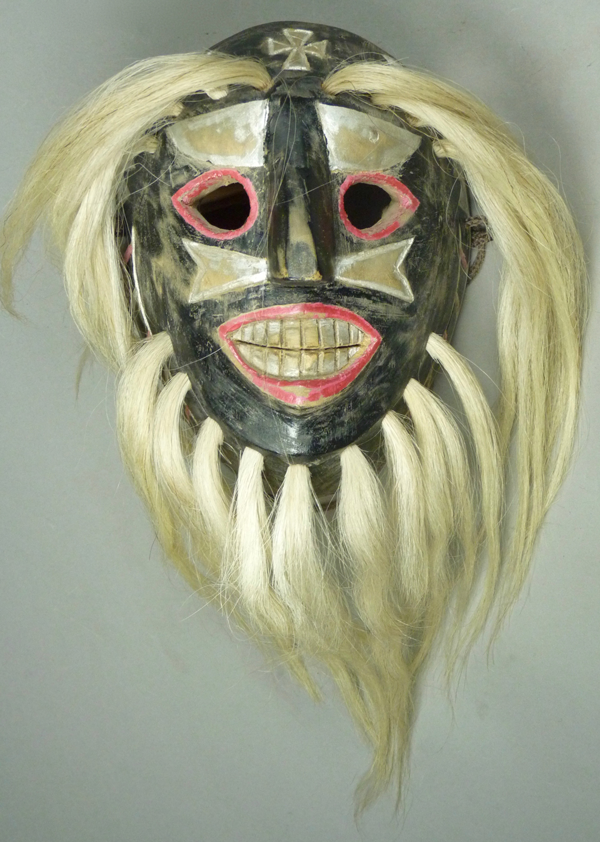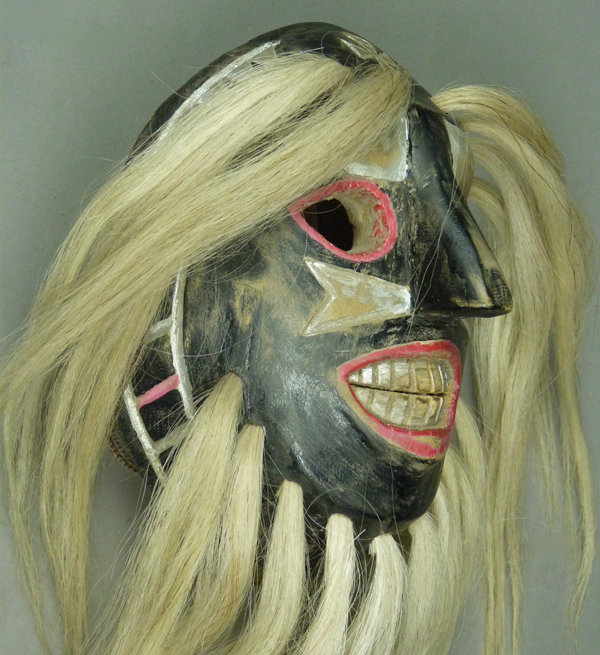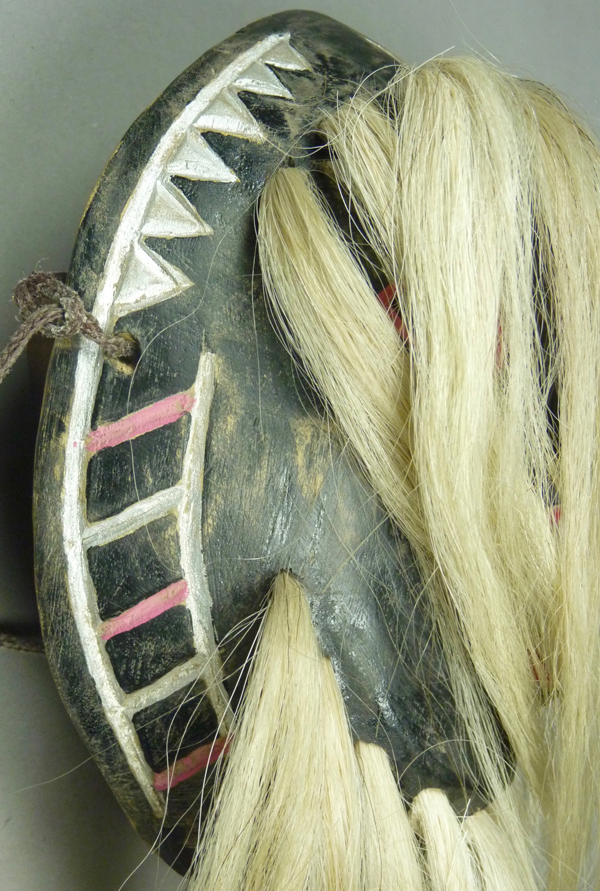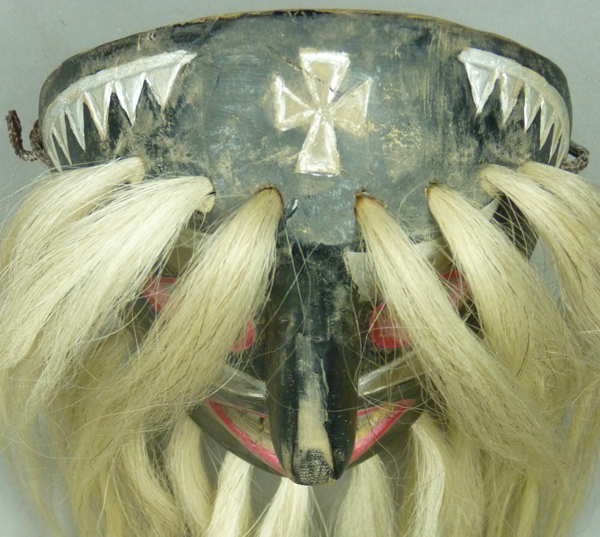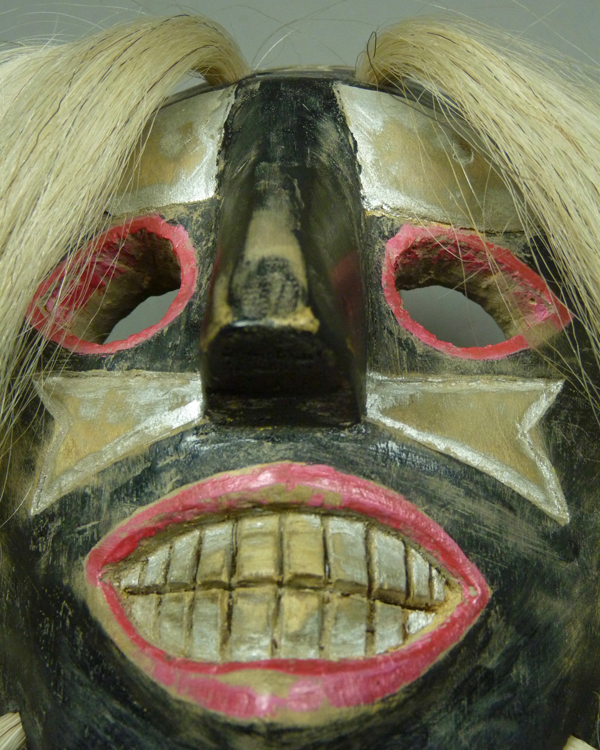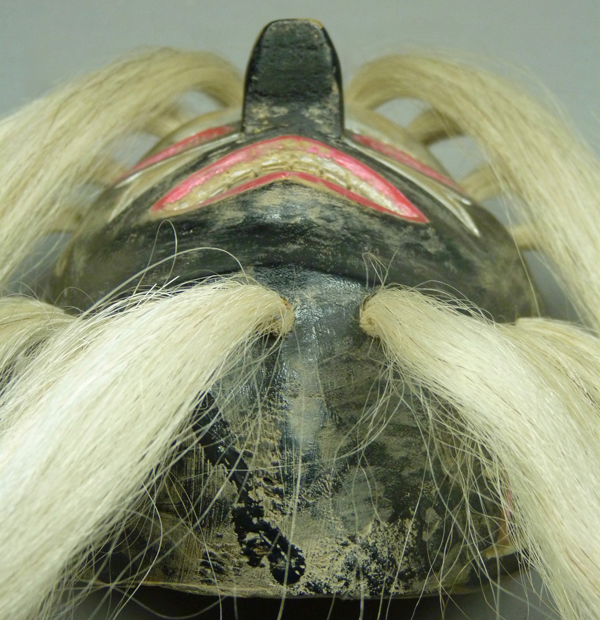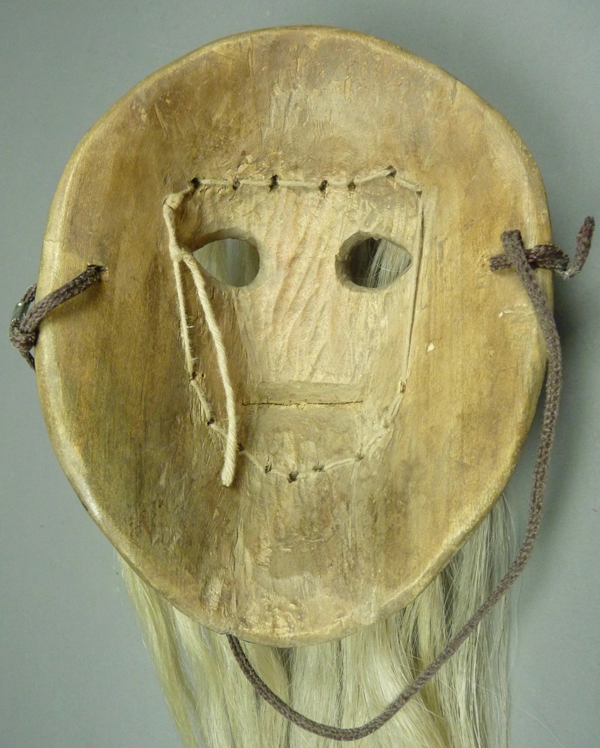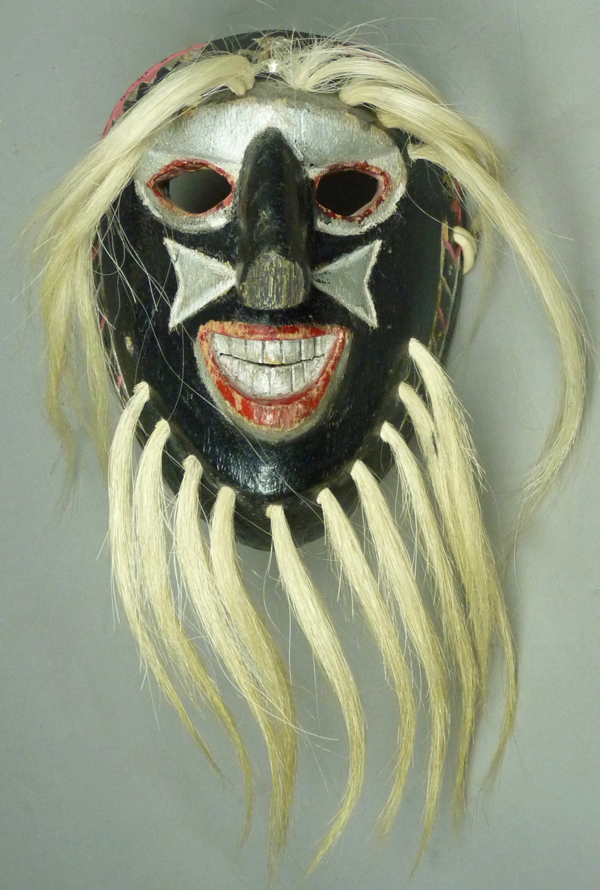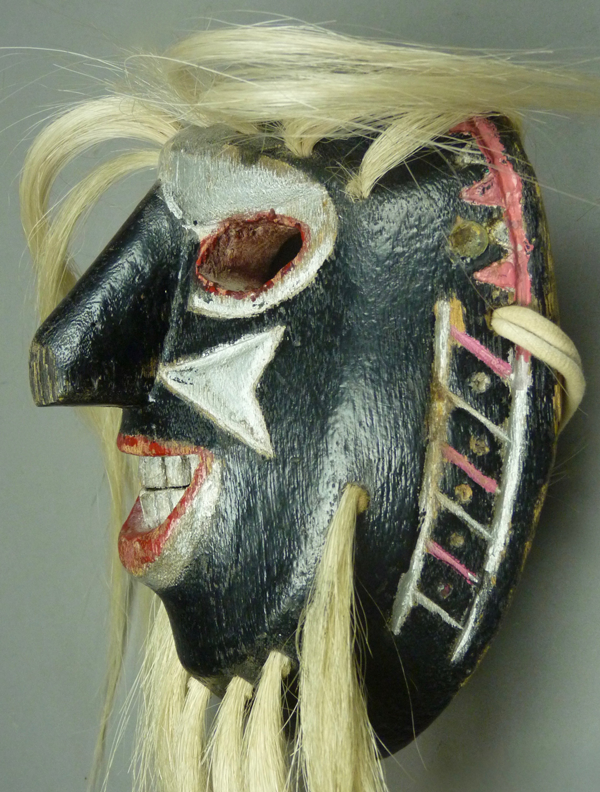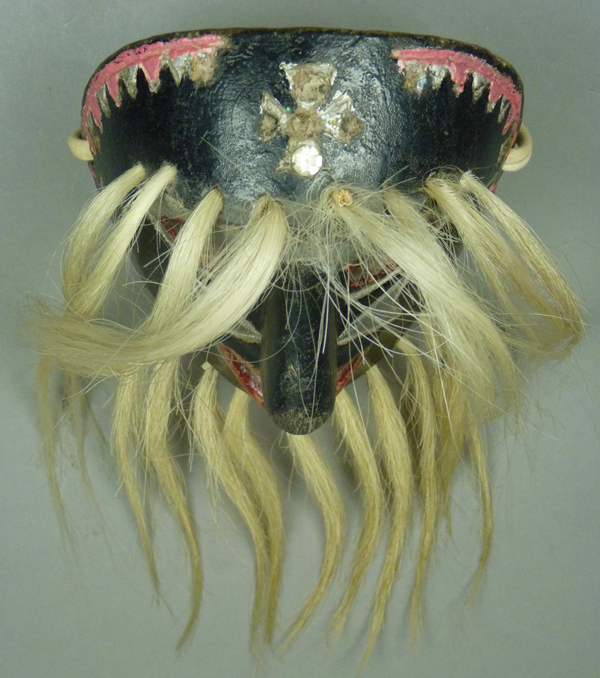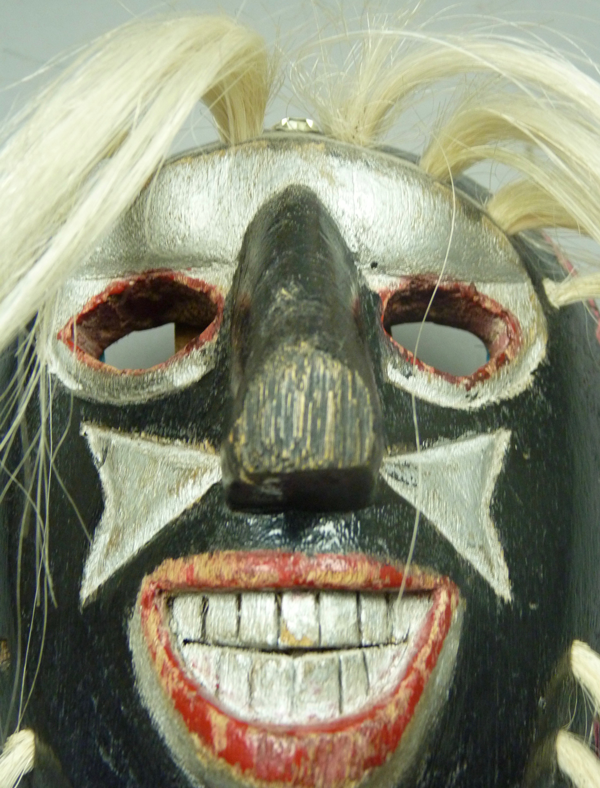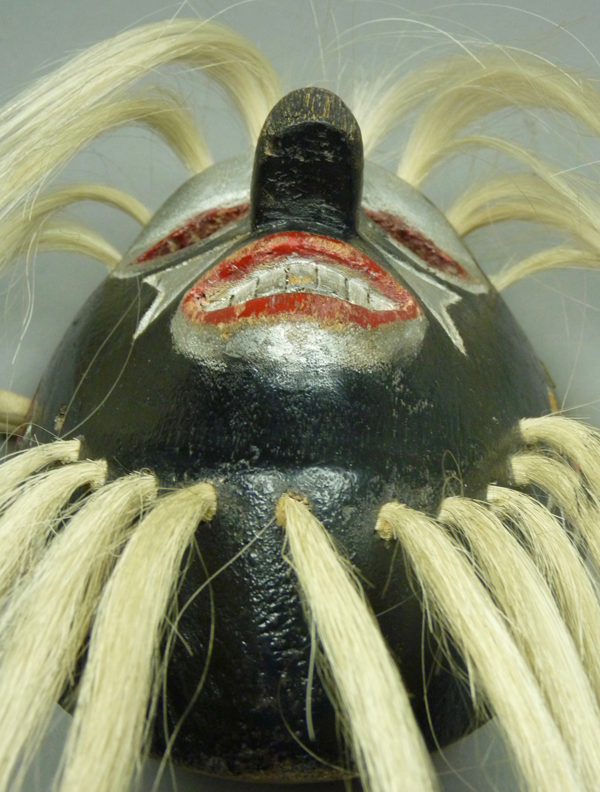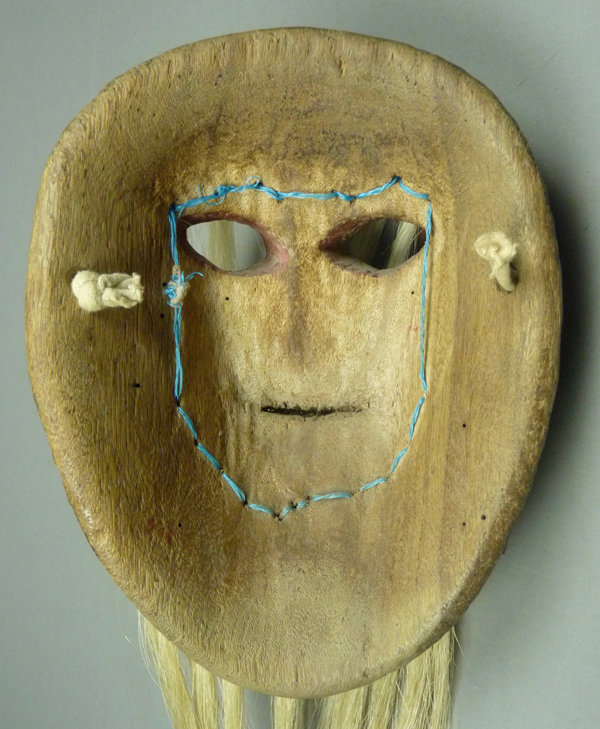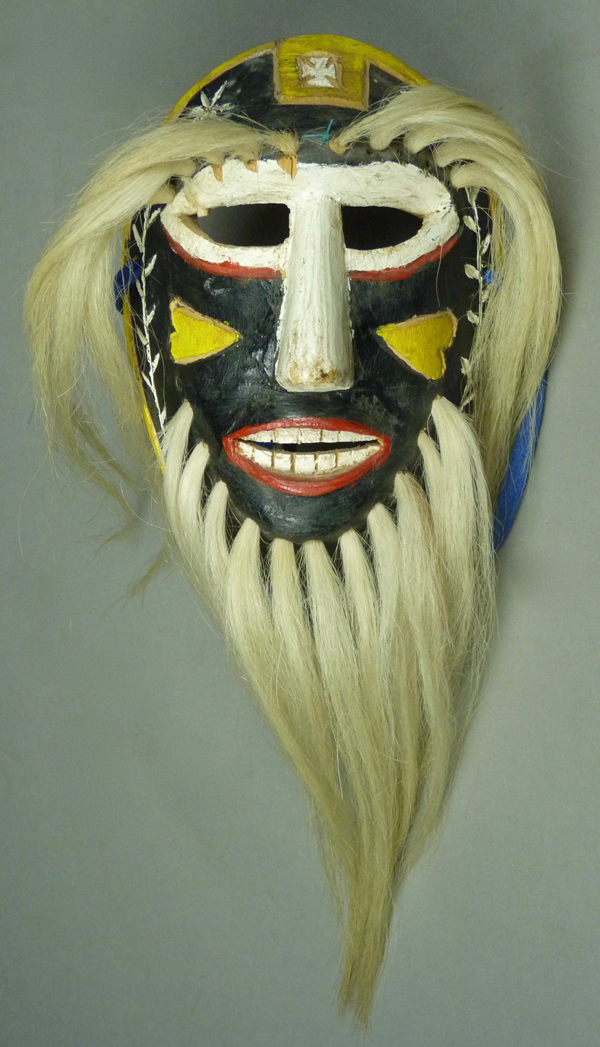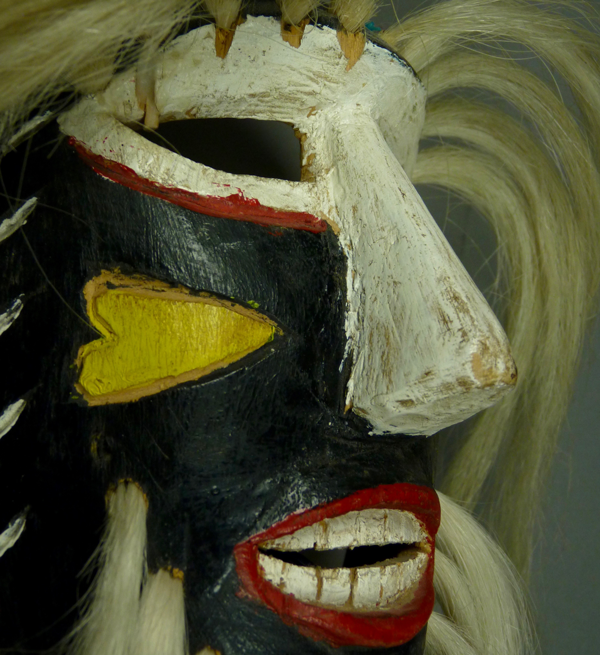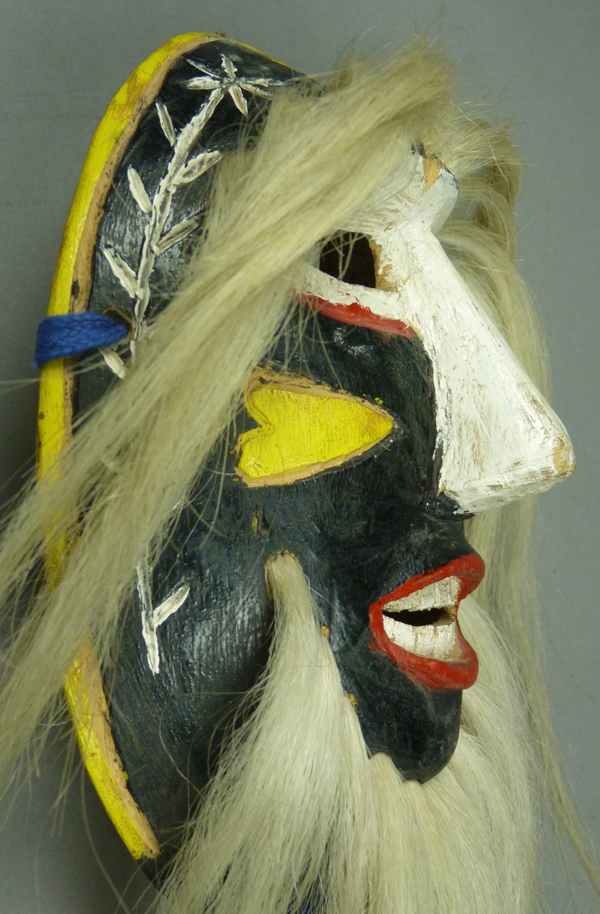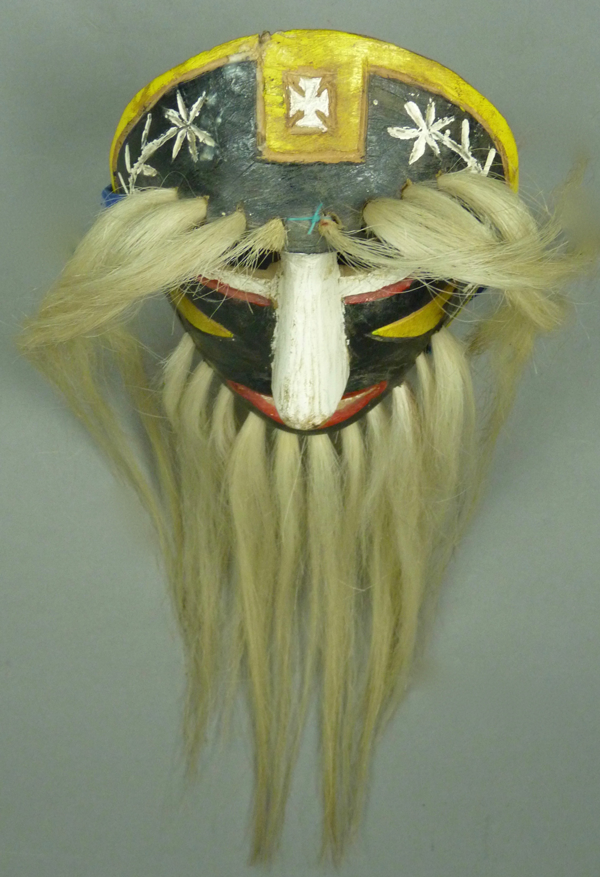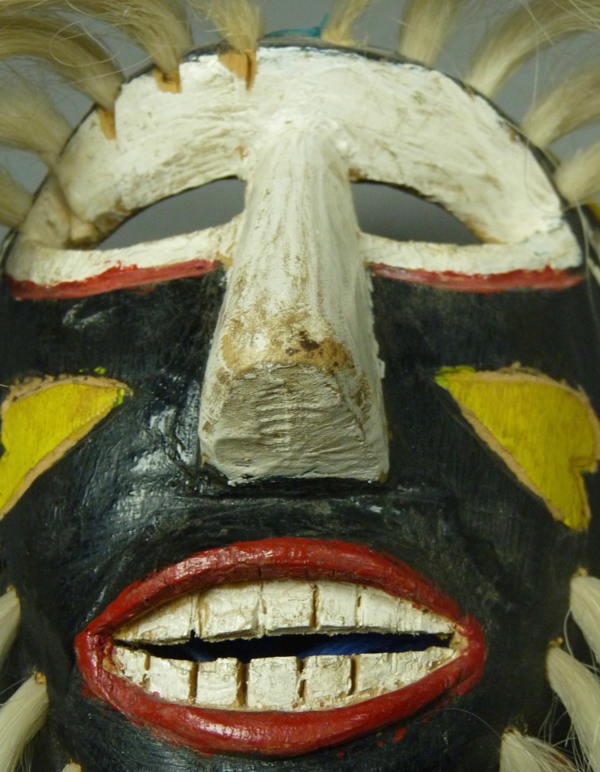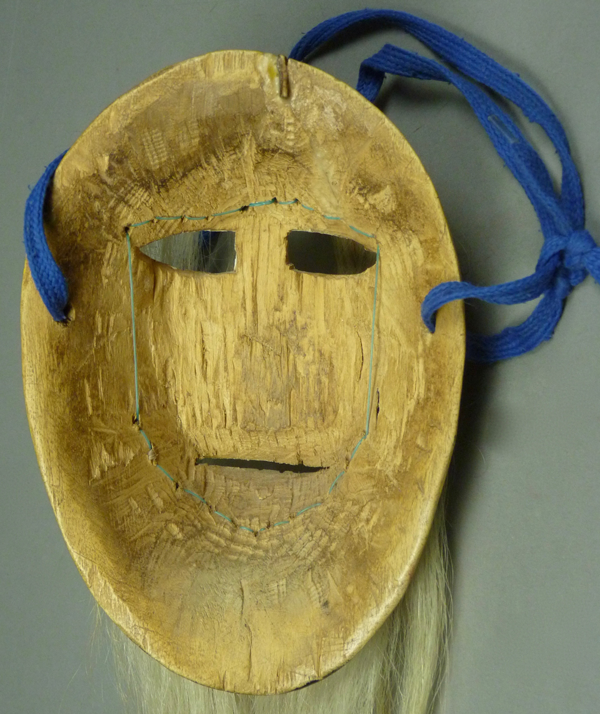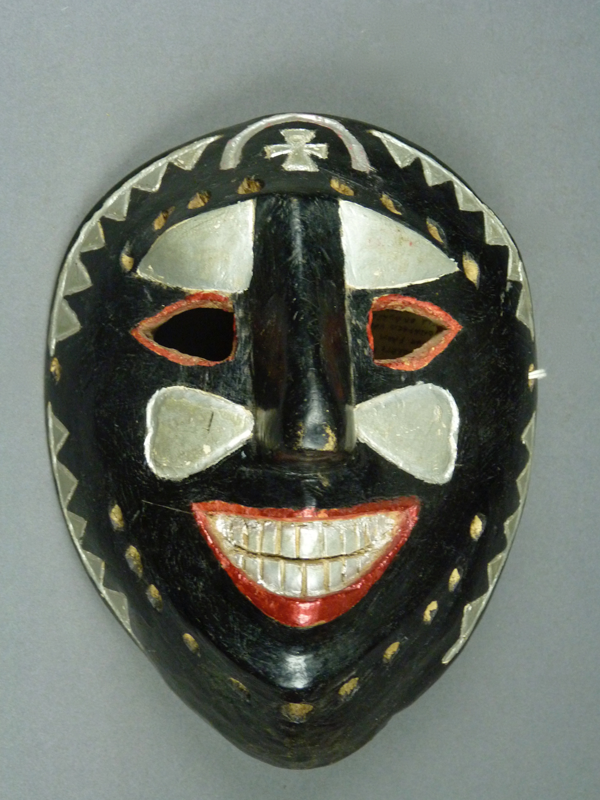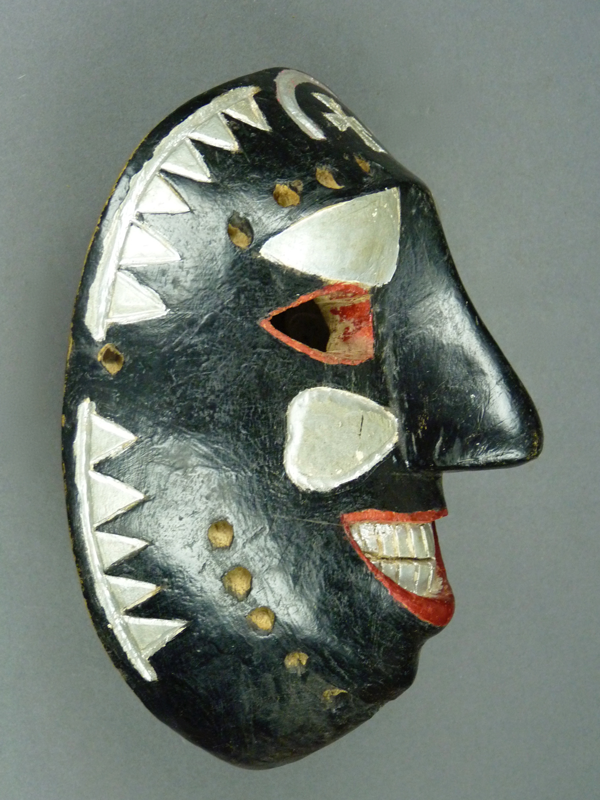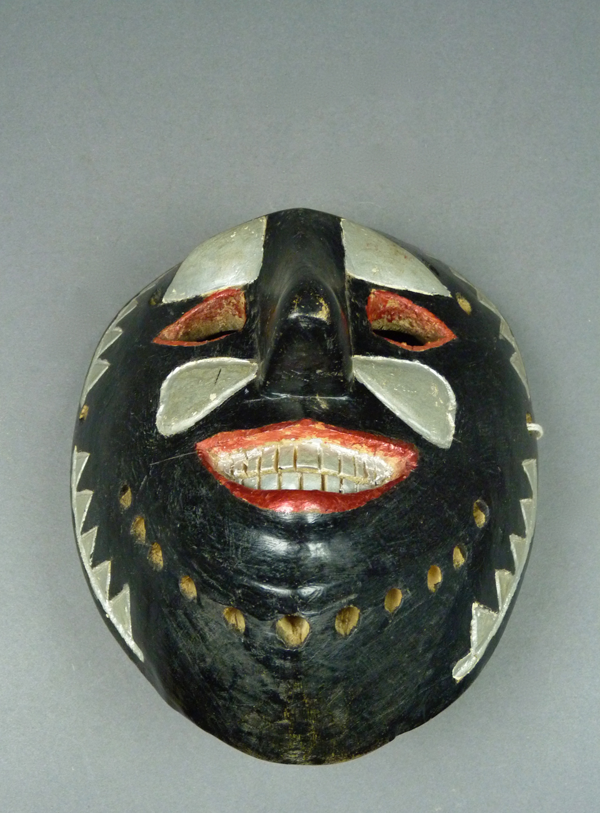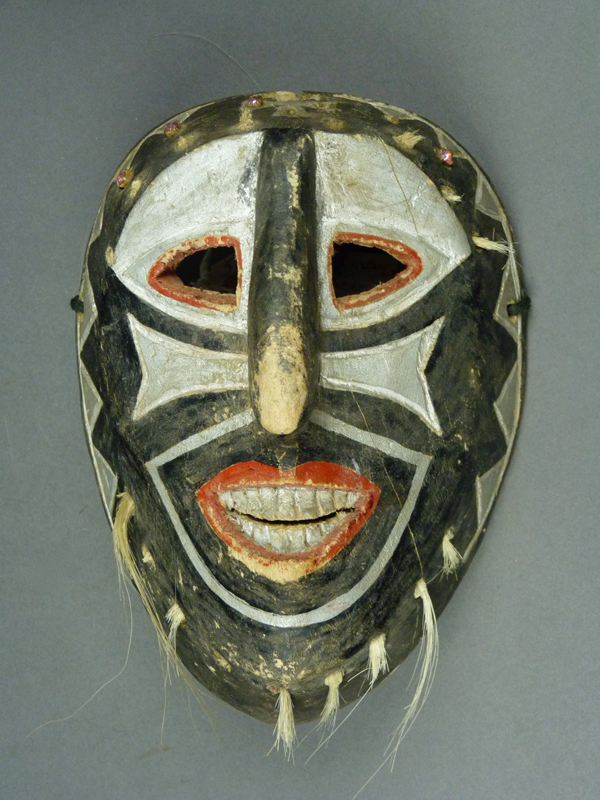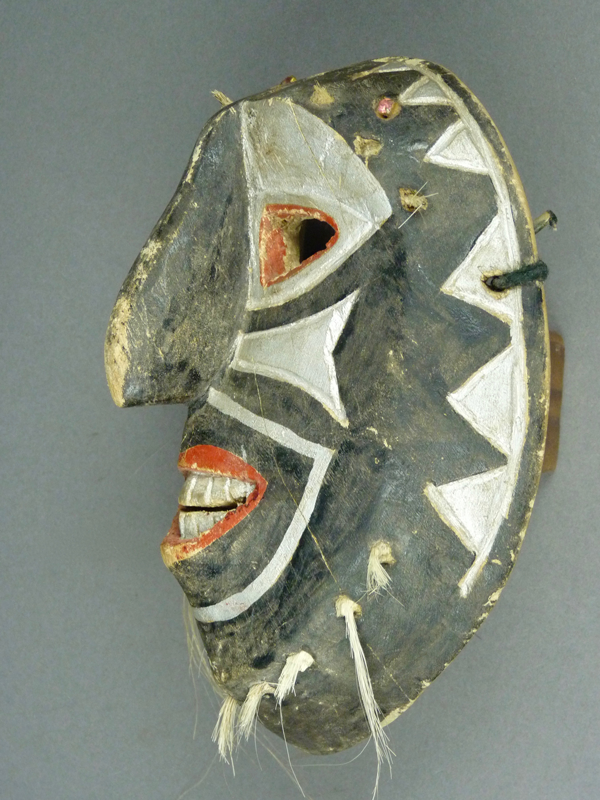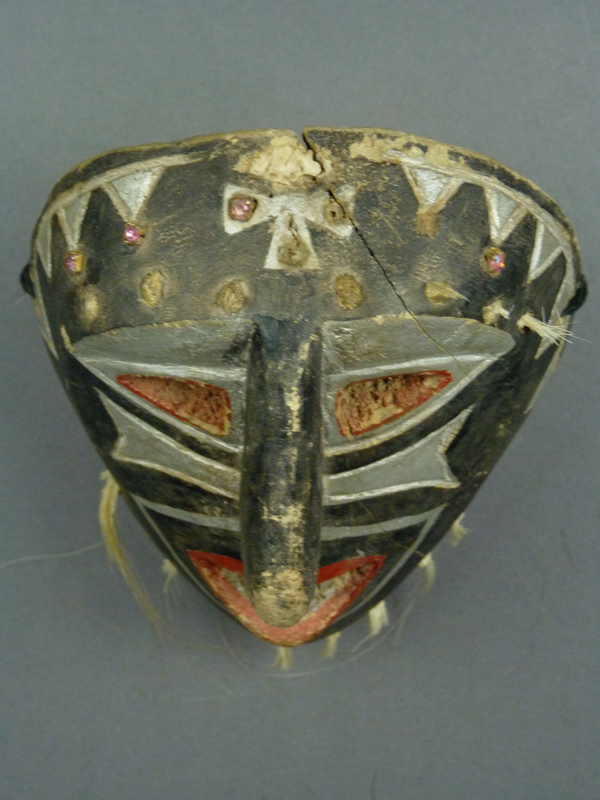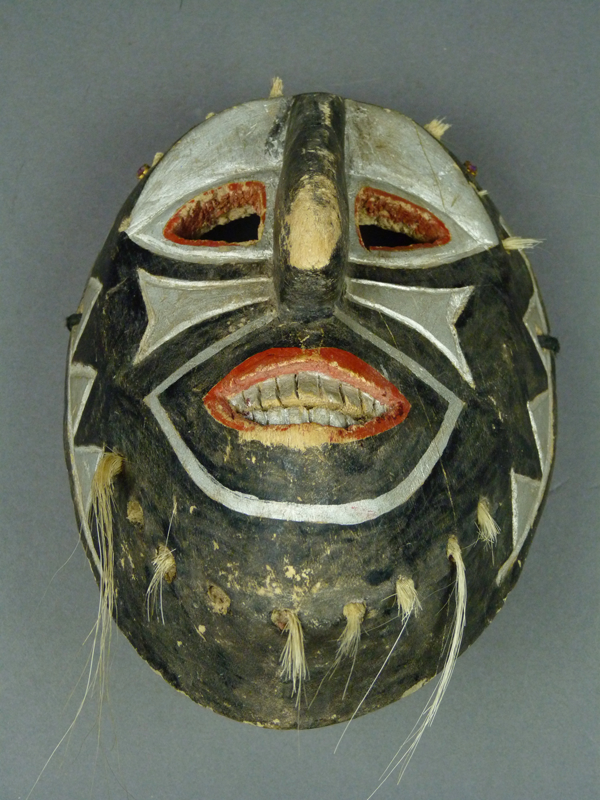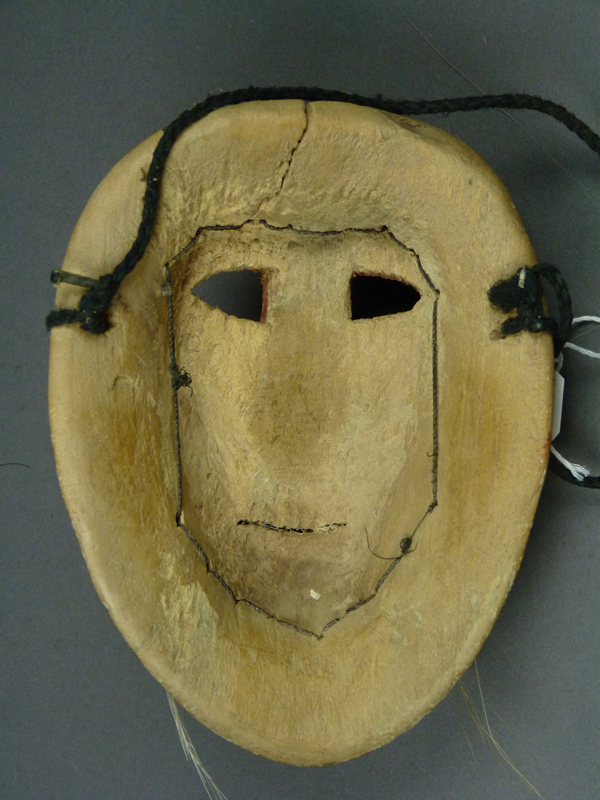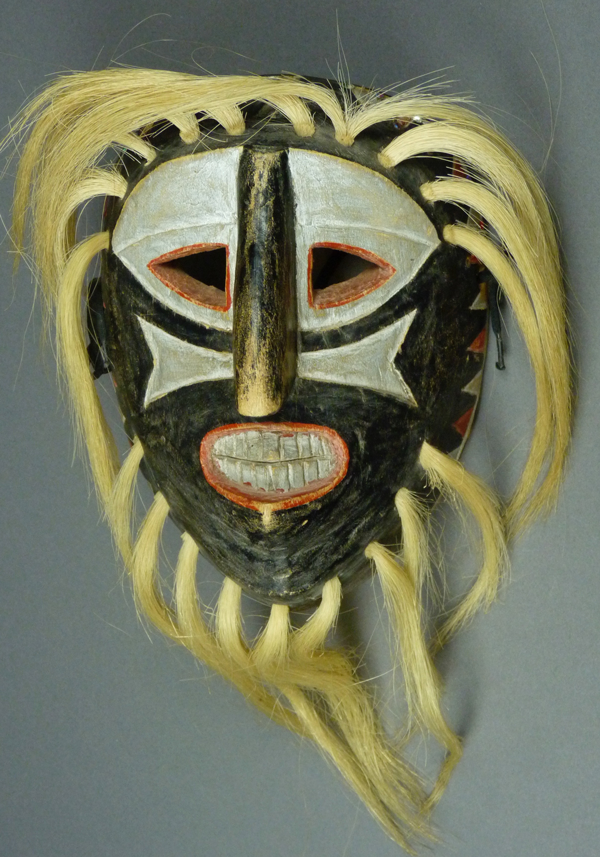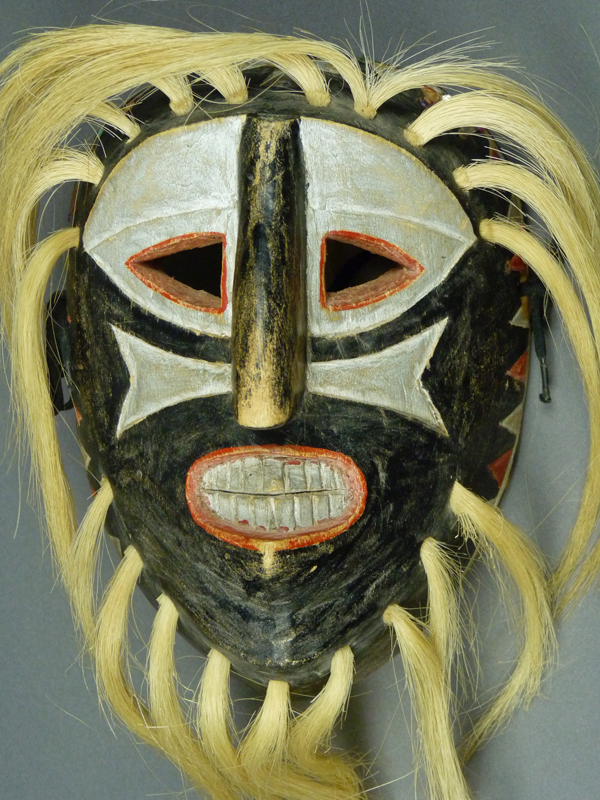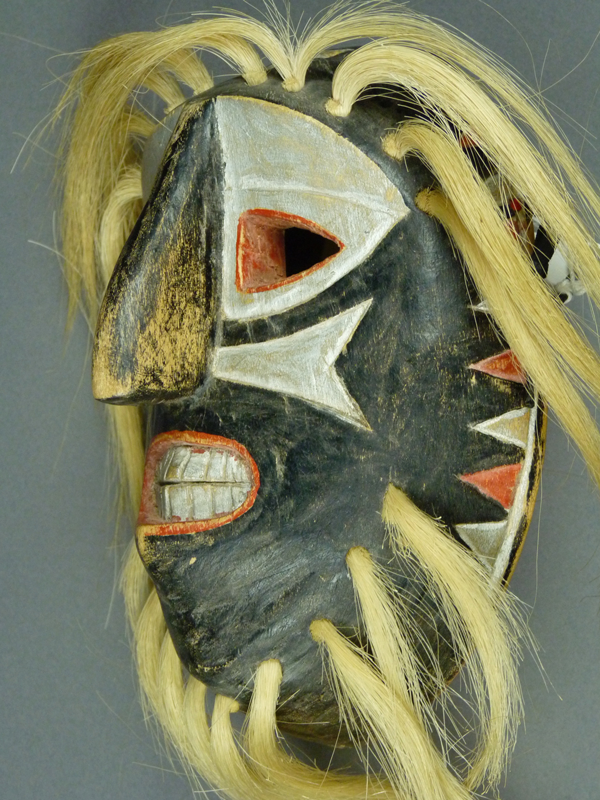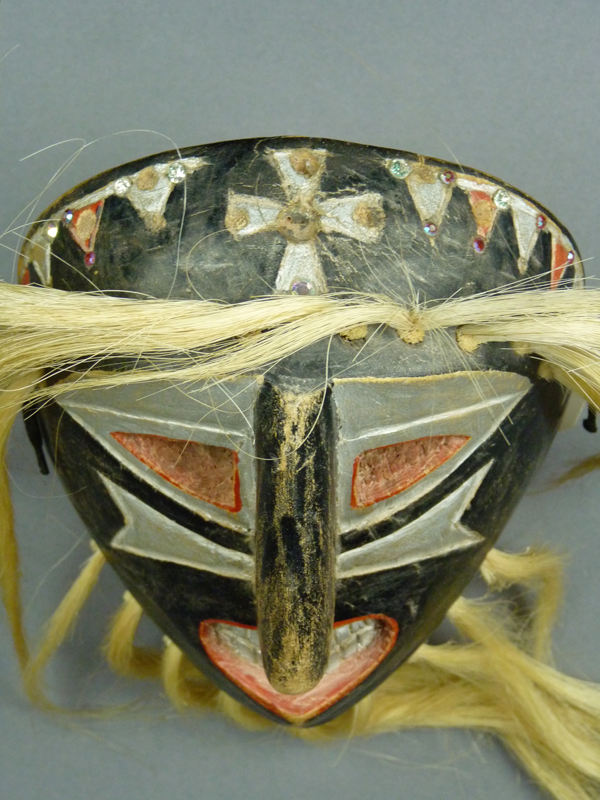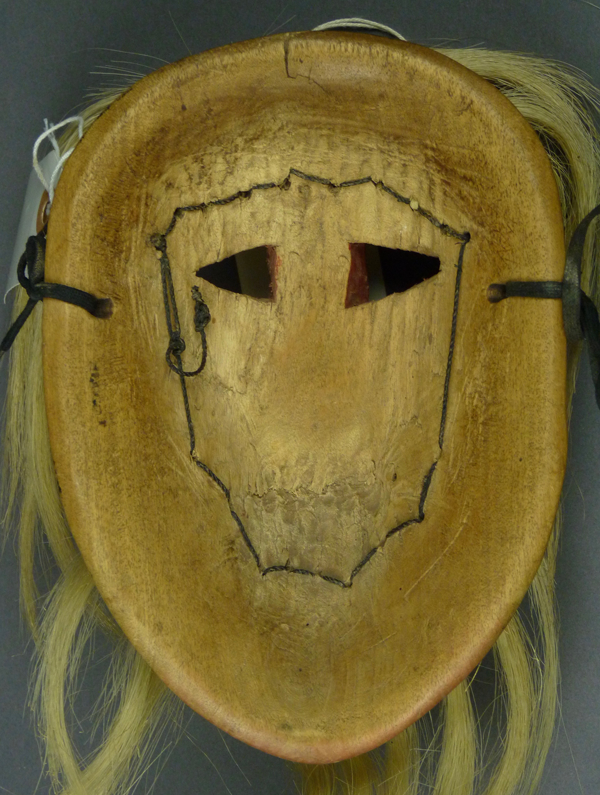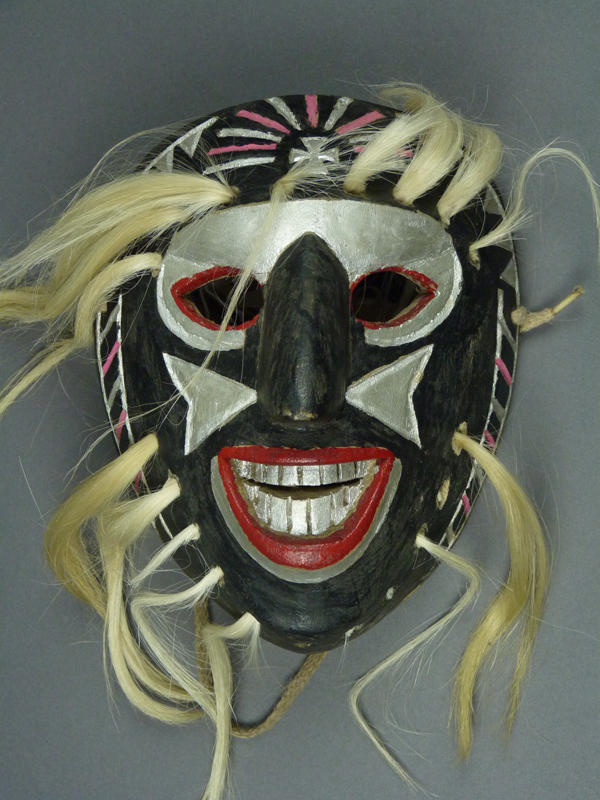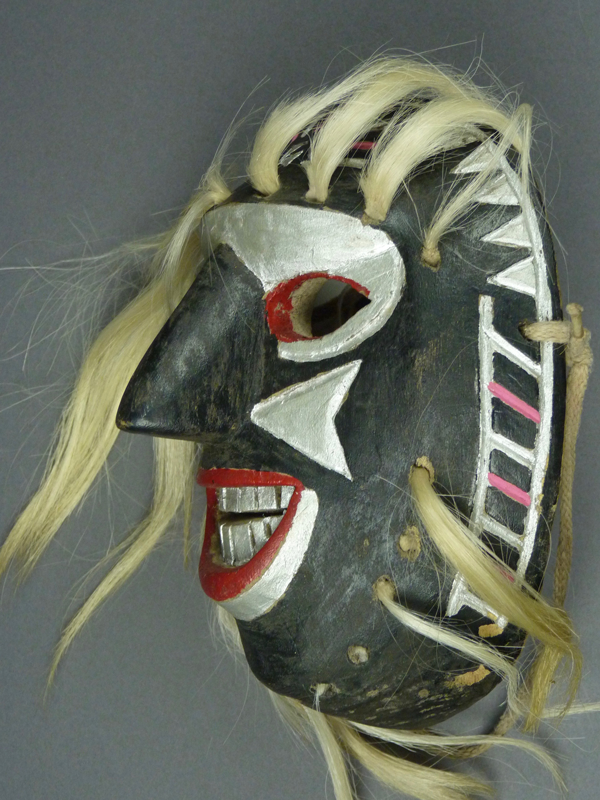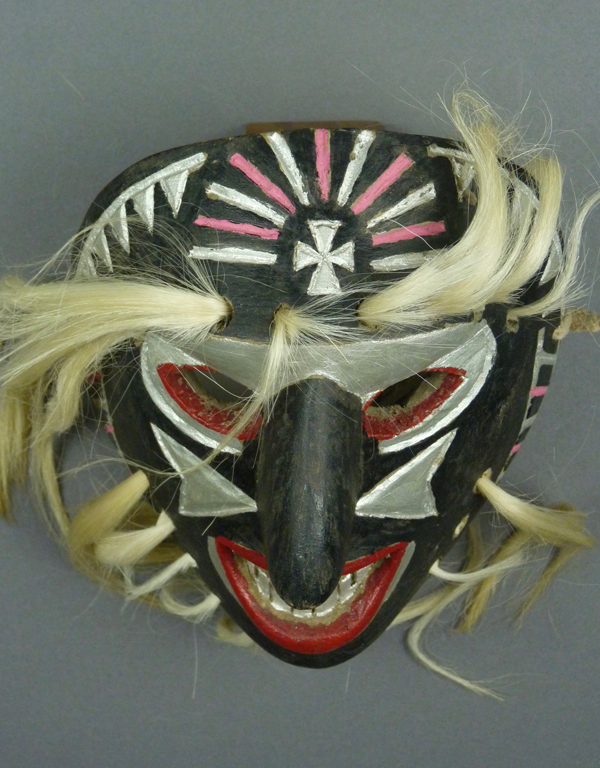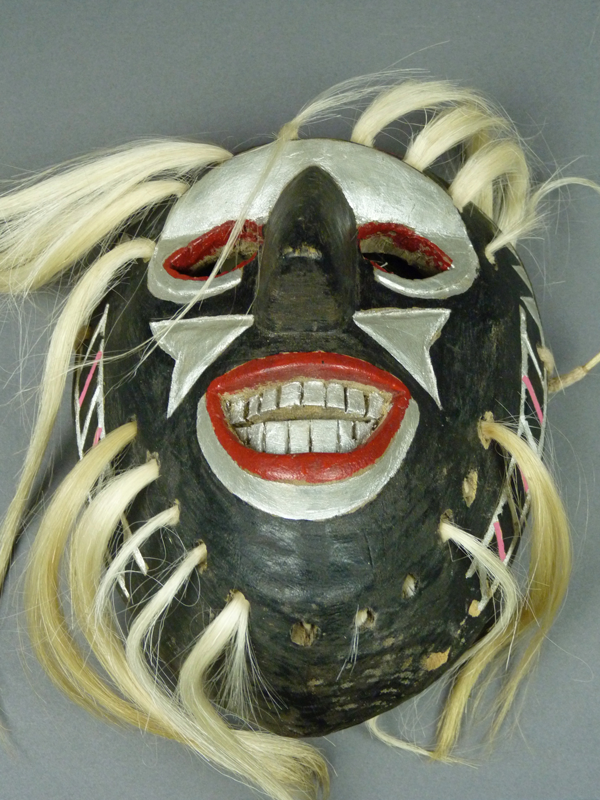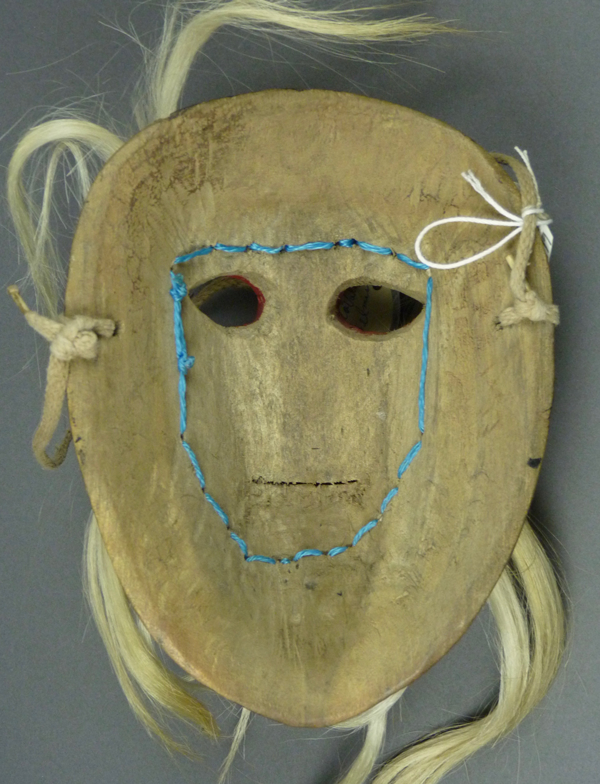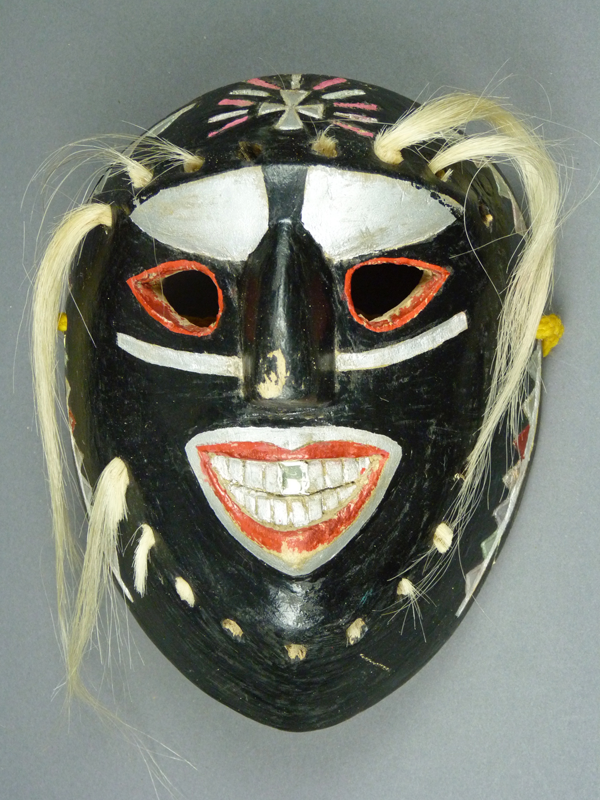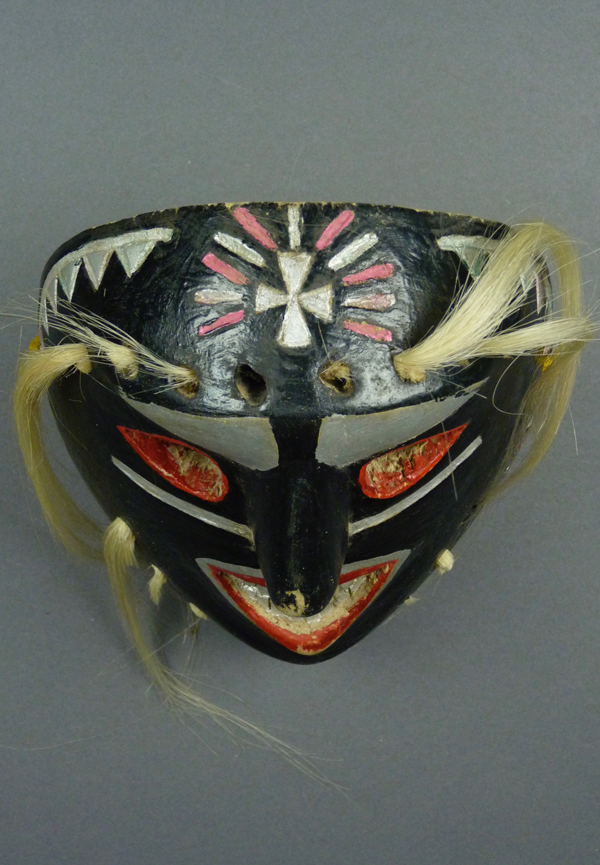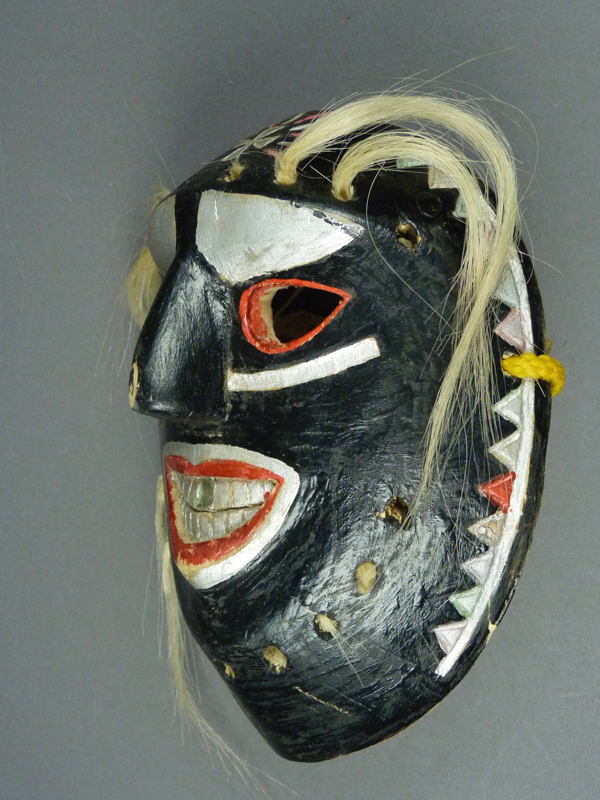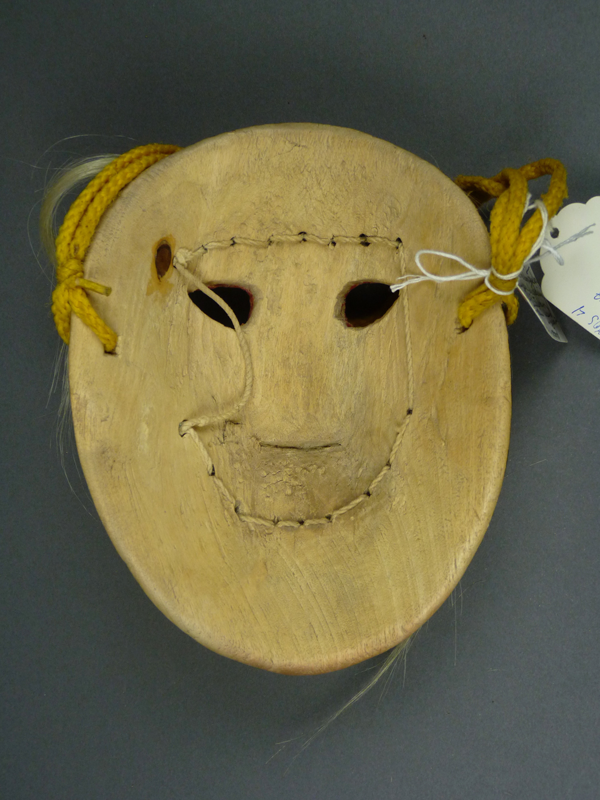This week I am introducing you more fully to another excellent and prolific Rio Mayo maskmaker, Bonifacio Balmea Sauzemea, of Guayparín, municipio of Etchajoa, Sonora, who is sometimes erroneously referred to as Bonifacio Valenzuela. I had inadvertently included one of Bonifacio’s masks from another collection in my post of September 10, 2018, thinking that it was a mask carved by Pancho Parra. Bonifacio’s masks often resemble those of Pancho Parra, so much so that one commonly finds masks in major collections that were made by one of these carvers but misidentified as the work of the other. I will start with a trio of masks by this artist that I purchased from Tom Kolaz in 1998.
This one was said to date from the 1960s. It has what I call “almond shaped ” eyes, which are commonly seen on Bonifacio’s masks, but alternating with other eye designs, and all these options are to be found on the masks of other Rio Mayo carvers. The rims of these particular eyes are painted but not elevated (not carved in relief).
Bonifacio also chooses from a number of mouth designs. I will call this one a “pointed grin,” when comparing it to his other favorites. Mouths with either flat or curved upper lips and pointed ends are characteristic for this carver, and one could call them auxiliary identifiers, but they too are sufficiently generic that they don’t distinguish one carver from another.
When examining a mask carver’s work, one looks for clusters of features that are distinctive to that artist. Those that are relatively enduring may serve as markers to identify that carver’s work over much of his career. However, most artists vary their work in some ways to suit themselves, and probably few consciously strive for consistency, so I count us fortunate if such markers emerge. There is one feature that does allow one to identify Bonifacio’s masks with relative certainty—the shaping of the nose—and another that is absolutely diagnostic when present, a specific manner of carving the spaces over the eyes. Taken together, these two features often allow us to select his work from a sea of anonymous or mislabeled candidates. I had relied on both of those design details to determine that one mask in the September 7 post was Bonifacio’s, and not the work of Pancho Parra. Ironically, Bonifacio’s nose designs demonstrate considerable variety or progression, yet they continue to fall within certain limits, permitting us to look for three nose designs containing an extensive number of variations.
Let’s look at the nose on this mask:
1. It does not narrow to a point at the top. That is, the width of the nose does not taper much as it approaches the top of the mask; instead the overall width remains nearly uniform.
2. The front surface can be completely flat from top to bottom, or there can be a transitional section which either arches or dips, followed by a lower section that is more or less flat and straight. In this first mask there is a transitional section that is arched and then dips.
3. The underside of the nose is essentially flat, although there is often a subtle graceful shaping there that resembles a stretched out tilde (~), such as on this mask.
Let’s call this a Bonifacio Type 1 nose. As already noted, this will refer to a range of variations, rather than to one specific design.
While looking at the nose, also notice that the chevron shaped wedges that flank the nose are carefully aligned near the nose’s lower edge. Pancho Parra’s wedges tend to be placed somewhere in the middle between the top and lower edge of the nose, and they are not very precisely located.
The rim design on a mask by Bonifacio often has two linked designs that are connected by a base line near the edge of the mask. Often, as in this case, there is no real gap between the two styles.
Here is the forehead cross, composed of four intersecting triangles that were carefully outlined by inscribed lines. The rim design was carefully carved as well.
In these photos you may be able to see that the width of the nose is nearly (but not precisely) uniform and that the upper edge of the nose varies from rounded to nearly flat. As you will come to understand, I am not using terms such as straight and flat as absolutes, but to highlight features that contrast with those on the noses of other masks carved by Bonifacio.
In the close-up shot immediately above one can see the second important diagnostic feature that may identify a mask by Bonifacio,. The more or less triangular areas over the eyes are often not flat, but mildly convex, so they sometimes appear to be bulging. In this example the convexity is difficult to see in a photo, but it is easily felt if one is holding the mask. The areas of worn paint are in fact the areas that are bulging. In contrast, the equally worn chevron shaped designs flanking the nose don’t rise above the contour of the face; they are set off from the cheeks by carved borders.
Bonifacio’s masks do not have a chin cross, nor does the rim design continue under the chin. The mouth bends around the face. On Bonifacio’s masks this is usual, but the degree is variable; a few of his mouths seem nearly flat.
This mask is 7 3/8 inches tall, 5 5/8 inches wide, and 3½ inches deep.
The back of this mask is impressively stained from use.
The second mask was said to date from the 1970s. It has an almond shaped right eye (pointed on the outside corner), while the left eye is oval (no point).
The bulging area over the eyes is immediately obvious on this mask.
This mask has a nose in a different Bonifacio design from the first; I will call it Bonifacio Type 2. In this version the nose is not flat on top; instead it has a sharp or rounded central peak that is present from the top to the base. Nor is it as tall, as it ends mid- brow rather than extending to the top of the mask. On the other hand, it does still have a uniform width like the Type 1 style. It tends to follow the contours of the areas over the eyes in the same manner that Pancho Parra’s noses do, which is one reason why the masks of the two are often confused. The end of this nose is scuffed from careless handling, giving it an appearance of being blunt on the end, but this is an illusion. It is rounded by wear, but not flat.
The prominent triangles over the eyes are particularly obvious in this side view. The rim design on this mask is very similar to the last, with one design style linked closely to another. The chevrons flanking the nose are located slightly above the nose’s bottom.
This forehead cross had jewels, just like so many on masks by Pancho Parra, as this was apparently once a local fad.
Here is another view of the bulging areas over the eyes. Also note the integration of the top of the nose with this area.
This mouth has a horizontal upper lip and the corners are softly pointed. The end of the nose is severely scuffed, as if the dancer fell while wearing his mask. The damaged area was sanded and roughly repainted.
Here is another mouth that curves around the jaw.
This mask is 7 ¾ inches tall, 5 5/8 inches wide, and 3½ inches deep.
This back too is well stained from use.
The third mask was collected from a Pascola dancer in 1992, in Guayparín; he said he had danced with it for about 12 years, and that it was carved by Bonifacio circa 1980. Some design elements on this mask are unlike those Bonifacio usually used, and I don’t know whether he was actually the artist who made it.
This mask has yet another nose design, which we could call Bonifacio Type 3, or simply characterize it as a pestle-shaped nose, tapered and round in cross section.
The heart shaped wedges on the cheeks are uncommon, and weren’t placed near the nose.
The rim design is also very different from Bonifacio’s usual style.
On this mask there appears to be a very tight integration between the eyes and the nose.
There is more space between the upper and lower jaws than usual, for Bonifacio.
This mask is 7 ¼ inches tall, 5 ½ inches wide, and 2¾ inches deep.
This back of this mask has good soiling from use; it has been heavily danced. The shape of the back is not unlike the backs of the other two masks.
Although this mask was reportedly carved by Bonifacio, and this from a dancer who must have known him well, the usual signs I use to identify Bonifacio as the carver are not present. Nor do I have a similar example that demonstrates greater overlap with Bonifacio’s usual style. So, I don’t really know whether this is a mask by Bonifacio. However, I have available to me numerous photos of masks that closely resemble the other two in this post, some with Type 1 noses, others whose noses are Type 2, and at least one that falls somewhere in between. Next I will show you a few of those. All five of these masks were photographed from the collection of Barney Burns and Mahina Drees, in 2016, with the kind permission of Mahina.
This next mask was collected directly from Bonifacio Balmea Sauzemea in 1988, after five years of use. The eyes are almond shaped with painted rims
This mask has bulging triangles over the eyes, wedges on the cheeks that remind one of those by Pancho Parra, and a typical Bonifacio mouth. The rim design is briefly discontinuous. The forehead cross is enclosed in a carved arch.
This type 1 nose is very similar in profile to the one on the first mask.
Seen from above, this nose has a uniform width and a softly rounded central ridge.
The chin is unremarkable—no cross and a discontinuous rim design.
The well worn back is otherwise unremarkable.
The next mask was collected as a mask by Bonifacio Balmea Sauzemea of Guayparín that had been danced for three years, but no date of collection was recorded. It has triangular eyes, meaning that the inner borders (adjacent to the nose) are straight and vertical. This is a style that Bonifacio used less often.
We find chevron shaped wedges flanking the nose, the eyes have elevated rims, and the areas above the eyes are bulging. The mouth has what amounts to a flat upper lip, but this lip is carefully shaped into two lobes, which is unusual for lips on Rio Mayo masks in general.
We see another Type 1 nose that generally resembles the others, but with subtle differences.
The cross is of a typical design but it lacks the usual carved border. Only one arm of the cross retains a jewel, although many remain on the rim design.
This is another mask with a scuffed nose tip.
There are no surprises on the chin.
The back is stained from use.
This next mask was collected as the work of Bonifacio Valenzuela of Guayparín, Sonora, it had been danced for three years, and no date of collection was recorded.
It is unclear whether the areas over the eyes are convex, but there is a raised triangular rim around the triangular eyes, which creates a similar effect. The mouth has an oval shape.
This is a Type 1 Bonifacio nose (it has a flat centerline and extends to the top of the mask) that is shaped like one of his Type 2 noses.
In this case the rim design is continuous above the chin.
The forehead cross is in Bonifacio’s usual style. Again, only one jewel remains.
The back of this mask is heavily stained from use.
This next mask was also collected as the work of Bonifacio Valenzuela of Huayparín (Guayparín) after it had been danced for two years. Again the date of collection was not recorded.
We see Bonifacio’s usual rim design of two elements linked together, and one of his favorite mouth designs with the level upper lip. The area above the eyes is bulging.
This is a Type 2 nose. The chevrons flanking the nose are crisply carved, as usual.
The forehead cross is surrounded by rays of light.
The teeth are parted, a less usual feature that we did see on the mask with heart shaped wedges. The bulge above the eyes is easily seen from this angle.
This back is moderately stained from use,
The last mask was collected as the work of Bonifacio Balmea Sauzemea of Guayparin, Sonora, after having been danced for four years. The date of collection was not recorded.
There is that upper lip with two lobes again. The bulge is visible over the eyes.
The rays around the forehead cross are similar to those on the last mask.
Here is another of those Bonifacio Type 2 noses
By now we are very accustomed to seeing these almond shaped eyes with painted rims.
There are no surprises at chin level.
The back demonstrates mild to moderate wear.
I gave you an intensive dose of Bonifacio’s masks so that you could readily scroll up and down to compare one to another. I particularly wanted to show the range of his nose designs.
I hope that you found this interesting and informative.
Next week I will introduce the masks of Plácido Alamea.
Bryan Stevens

